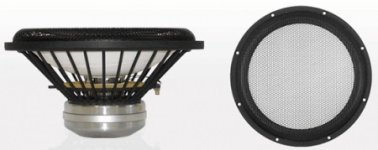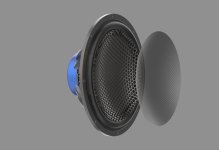u-sound
Active member
you can press a tweeter yes, but not a billet dome.
have a look at the precision as well
have a look at the precision as well
Considering Magico prides itself on developing all drivers in house I'd be surprised if they leveraged drivers from any vendor especially for their new flagship M9. My information comes from the Magico site. The M9 - A Revelatory New Flagship Loudspeaker — Magico Loudspeakers
the 11" Magico bass driver (2 per tower) has lot's of common design attributes to this Accuton 11" bass driver (of which there are 4 of in each of my speakers).
Accuton S280-6-282 11" Sandwich Cone Woofer
likely not an accident. my MM7 passive towers are 97db efficient; if they only had 2 of these drivers they would be 94db efficient. and the M9's just happen to be 94db efficient. imagine that.
find another 11" woofer that covers 30hz to 250hz that is 92db efficient. you won't find one. only this one. which is why Magico choose it. then they modified it. nothing nefarious about it. i can tell you that no dynamic driver speaker can do mid bass like my speakers. and this driver is key to that. no crossover in the power range of the music. like a planar. with 4 there is little driver excursion. quite the effect. and with high efficiency you get ease in the amplifier. all around magical. Magico.
i've had my speakers for 8 years. so long before the M9's were even a twinkle in Alon's eye. if these 11" Magico drivers did not begin life as Accutons, then Magico certainly used the Accuton's as design inspiration.
the 11" Magico bass driver (2 per tower) has lot's of common design attributes to this Accuton 11" bass driver (of which there are 4 of in each of my speakers).
Accuton S280-6-282 11" Sandwich Cone Woofer
likely not an accident. my MM7 passive towers are 97db efficient; if they only had 2 of these drivers they would be 94db efficient. and the M9's just happen to be 94db efficient. imagine that.
find another 11" woofer that covers 30hz to 250hz that is 92db efficient. you won't find one. only this one. which is why Magico choose it. then they modified it. nothing nefarious about it. i can tell you that no dynamic driver speaker can do mid bass like my speakers. and this driver is key to that. no crossover in the power range of the music. like a planar. with 4 there is little driver excursion. quite the effect. and with high efficiency you get ease in the amplifier. all around magical. Magico.
i've had my speakers for 8 years. so long before the M9's were even a twinkle in Alon's eye. if these 11" Magico drivers did not begin life as Accutons, then Magico certainly used the Accuton's as design inspiration.
I sure do like the midrange on the MBL 101’s and 101 Xtremes! I would definitely say their drivers are SOTA.
How It's Made Omnidirectional Speakers P1 - YouTube
How It's Made Omnidirectional Speakers P2 - YouTube
Hi Mike,
Reading Magico’s and Accuton’s description of their 11 inch woofers, it appears that Magico has used Accuton’s basket, neodymium magnets and titanium voice coil in their M9 speaker. The description is identical word for word. However, the speaker cones on the M9’s are designed, manufactured and unique to Magico as they utilize a carbon-graphene/aluminum honeycomb core/carbon-graphene sandwich proprietary design. This is a significant differentiator from Accuton’s ceramic sandwich speaker cones.
The M9 - A Revelatory New Flagship Loudspeaker — Magico Loudspeakers
Best,
Ken


... so now i had ceramic drivers from 30hz to 3khz. wow and double wow. no dynamic driver speaker i have heard can do what the MM7's do in these frequencies. ceramic is inherently stiff and light, and retains linearity and lack of distortion.
Sorry, something happened to the link that was meant to be included?
High-end acoustic speaker with absolute neutrality | Sonus faber
Driver materials do matter – at least in this designer’s opinion. The video shows analysis for two mid range drivers, an ultra-rigid carbon-fiber/balsa core design vs. “a very expensive paper driver cone that is employed in some very high-end speaker designs.”
Source: “The Truth About Pistonic Driver Cones”, The Truth About Pistonic Driver Cones | Vandersteen Audio Accessed 20 Dec 2020.
According to Richard, his speakers are time and phase coherent. I assume he would know. I adjusted my post to reflect this.
Ken
No doubt speaker efficiency as commonly specified is of limited use in determining amplifier power requirements. It is interesting, though, that in general the more "efficient" a speaker system the flatter its impedance curve tends to be. Not surprising, though, since these speakers will typically have simpler crossover networks and often more powerful magnets for a given driver size.
